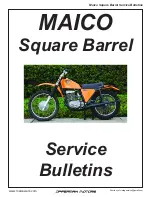
55
ENGLISH
1. Composition and Function of the Control Part
In the electric system of the motorcycle, the control portion assures the normal operation of the power
supply portion and the electricity consumption portion, as well as the harmonization among them, and
enables the driver to control the electrical system at any time.
The control portion is mainly composed of a regulator, a rectifier, flicker relay, a a starting relay, a fuse
protector, a control switch and an electrical cable assembly.
1)Regulator
The regulator is an important control element of the power supply portion of the motorcycle electrical
system. It can be divided into two types: DC generator regulator and alternator regulator according to the
generator form.
[1.]DC generator regulator
As the output voltage of DC generator regulator is proportional to the rotate speed, it results in some
problems:
[a] When the vehicle is running at a high speed, the engine speed is higher, and the DC generator
connected to the engine outputs very high voltage. Thus it is easy to burn out the electrical equipment and
make the battery over-charged.
[b] When the vehicle is running at a low speed, the engine speed is lower, causing the battery to
discharge a large current to the DC generator and burn it out. Therefore, regulators are needed to work
together with generators.
[2.]Alternator regulator
In a motorcycle mounted with a magneto, a rectifier is installed to convert an alternating current
generated by the magneto into a direct current; a AC regulator is also required to stabilize the output of the
magneto.
Now more commonly used AC regulators are electronic. An AC regulator includes a transistor, diode
and thyristor and other components. When the magneto works, the lighting and signalling coils will
produce alternating currents.
2)Rectifier
Common rectifiers include single-phase half-wave rectifier and full-wave bridge rectifier. Both types
take advantages of one-way conduction property of a silicon diode to work as an electronic valve which
allows only one direction of current.
3)Flicker relay
Commonly used flicker relays, also known as scintillators, include three types: thermal resistance,
capacitance and transistor.
4)Starting relay
When the starting motor is at work the current is very large, reaching dozens of amperes. The starting
relay is actually an electromagnetic switch. When you press the start switch on RHS handlebar, the current
passes through the battery, battery terminal, relay coil, start switch terminal and start switch and a loop
forms by bonding.
5)Fuse protector
A fuse protector is typically made of a fuse holder and fuse tube therein.
6)Control switch
Various control switches of the electrical system are positioned on RHS and LHS handlebars.
Generally, on the LHS handlebar, there is a long-range dimmer switch, short-range dimmer switch,
sidelight switch and horn switch from top to bottom. On the RHS handlebar, there is a sidelight, headlamp
switch and electric start switch from top to bottom. A circuit master switch stays in the center.
7)Main cable
Various portions of the motorcycle electrical system are connected as a whole by wires. To avoid
clutter of wires wound together and for easy arrangement on the frame, the wires in the same direction are
often bundled with insulating tapes. This is a cable assembly.
Section 3 Control Part
















































